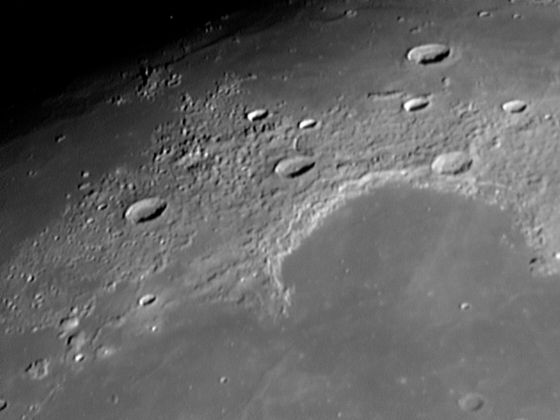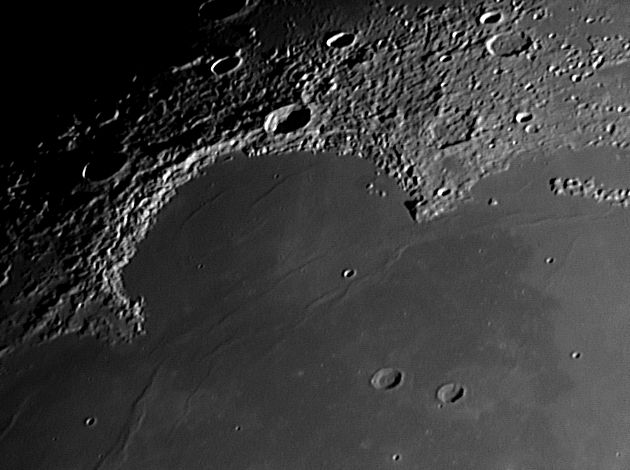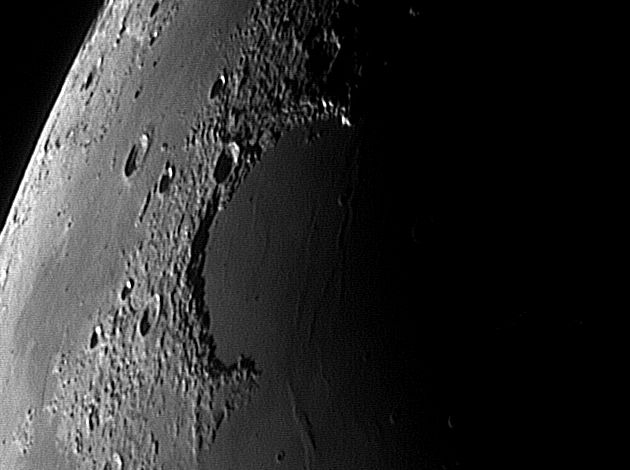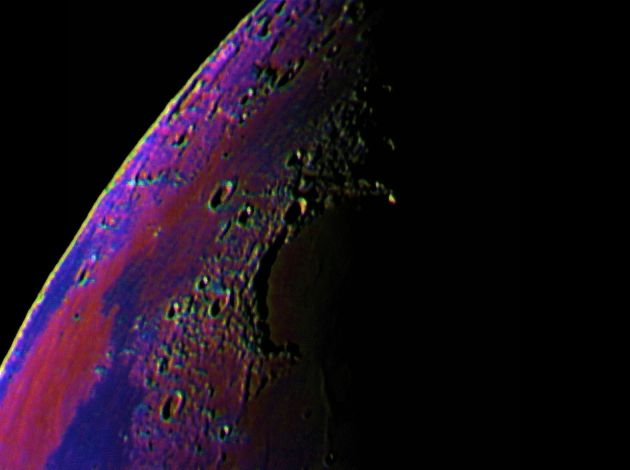

Move your mouse over the picture to see the names of the various features. The Sinus Iridum is a bay off the Mare Imbrium and is bounded to the north by the Jura Mountains. It measures some 410 by 265 Km and covers an area of 237,000 square kilometres. Although named a "bay" it is, in fact, a large impact crater that formed on the edge of the Imbrium basin before the latter filled with lava. So it was probably inclined from the start, or would have tilted if the Imbrium basin sank under the load the the lavas that flooded it later. Either way to southern rim has probably been covered with the lavas. However, look at Cape (Promontarium) Laplace. This is a large masiff which plunges steeply into the mare. Maybe a fault developped as Inbrium sank under the load of the lava. Who knows? Interestingly, its floor is some 600
metres lower than the floor of Mare Imbrium. To image this change of level would be quite a challenge.
Date and Time: 25th October 2004 22:34 UT
Date and Time: 12th November 2005 18:16 UT
Date and Time: 29th August 2005 04:40 UT

This picture was taken at day 12.6 of the lunar cycle so it was late morning over the bay and so there are few shadows to bring out the detail in the eastern part of the picture. As one approaches the teminator, however, these details become stronger.
Most of the craters in this picture date from about the same period (3,500 million year ago), except Harpalus, which is less than 1,000 million years old.
I've not put scale markers on this picture. Both the scale and the direction of north changes markedly in this area in the far north. To give some indication, however, Mairan and Harpalus are both on 43.4° west longitude and are 350 Km apart. The distance across the mouth of Sinus Iridum (from Cape Heraclides to Cape Laplace) is about 230 Km. and the maximum distance from this line to the northern shore is about 170 Km.
The picture was taken with a ToUcam attached to my LX200 on 25th October 2004 at 22:34 UT when the Moon was 12.6 days old.
Camera: ToUcam 740K
Telescope: LX200 at prime focus (FL 2500 mm)
Capture: K3CCDTools. High gamma, 1/500", 12% gain, 310 frames
Processing: Registax. 125 frames stacked. Wavelets 1,2 = 10

This picture of Sinus Iridum was taken slightly earlier than the picture above and in infra-red light. The wrinkle ridges that cross the bay are visible and may represent the edges of various layers of lava. The difference in albedo (brightness) of the lavas in the eastern part of the Mare are real and also shows up on a wider-angle exaggerated- colour image that I took the same night. Presumably the dividing line represents the edge of a layer of lava of somewhat different composition to the underlying layer.
The scale markers are very approximately 100 Km north and east and apply around Bianchini.
The picture was taken with a ToUcam attached to my LX200 on 12th November 2005 at 18:16 UT when the Moon was 11.4 days old.
Camera: ToUcam 740K with IR-pass filter
Telescope: LX200 at prime focus (FL 2500 mm)
Capture: K3CCDTools. Low gamma, 1/33", 33% gain, 484 frames
Processing: Registax. 98 frames stacked. Wavelets 1 = 10, 2 = 5, histogram 0-200

This picture of the area to the west of Sinus Iridum was taken when the Sun was setting
over this part of Mare Imbrium, and some of the wrinkle ridges are visible in Sinus Iridum.
Because of this later phase, the terrain to the west of Sinus Iridum is visible here.
However the libration was about as bad as it gets for this part of the Moon, so the
libration zones are hidden. For some reason, I have this picture tilted over compared
to the one above. However the scale markers are quite deceptive in pictures of this area.
For what they are worth (which is probably not much) the scale markers are very approximately
north and east and apply between Sharp and Harpalus.
The picture was taken with a ToUcam attached to my LX200 on 29th August 2005 at 04:40 UT when the Moon was 24.5 days old.
Camera: ToUcam 740K with IR-pass filter
Telescope: LX200 at prime focus (FL 2500 mm)
Capture: K3CCDTools. Low gamma, 1/25", 70% gain, 305 frames
Processing: Registax. 89 frames stacked. Wavelets 1 = 10, 2 = 5, histogram 10-200
 This is a picture of the same area as above but taken two months later and rendered in exaggerated colour. What I think these colours are showing are the different lava formations that are believed to have inundated the Oceanus Procellarum between about 3,800 million and 1,000 million years ago. In his book The Modern Moon, C.E Wood shows a diagram (page 164) of these lavas in the region of this picture, and the colours seem to correspond quite well. The blue area to the south of Sinus Roris is covered with Sharp lavas (named after the crater some 100 Km to the east) which are the youngest of these lavas at about 1,300 million years old. This lava is covered by ejecta from Harpalus further north which shows here in pink. Mare Frigoris is Sharp lava also, but is too dark to show the colour in this picture. The red area further west is Telemann lava which erupted some 2,000 million years earlier. Finally the deep blue area to the west of Markov may represent the oldest lavas called Repsold (after a crater right on the limb) which are 3,600 million years old. These lavas have also been excavated from below the Telemann lavas by the small crater Markov E.
This is a picture of the same area as above but taken two months later and rendered in exaggerated colour. What I think these colours are showing are the different lava formations that are believed to have inundated the Oceanus Procellarum between about 3,800 million and 1,000 million years ago. In his book The Modern Moon, C.E Wood shows a diagram (page 164) of these lavas in the region of this picture, and the colours seem to correspond quite well. The blue area to the south of Sinus Roris is covered with Sharp lavas (named after the crater some 100 Km to the east) which are the youngest of these lavas at about 1,300 million years old. This lava is covered by ejecta from Harpalus further north which shows here in pink. Mare Frigoris is Sharp lava also, but is too dark to show the colour in this picture. The red area further west is Telemann lava which erupted some 2,000 million years earlier. Finally the deep blue area to the west of Markov may represent the oldest lavas called Repsold (after a crater right on the limb) which are 3,600 million years old. These lavas have also been excavated from below the Telemann lavas by the small crater Markov E.
This represents an extraordinarily long time period for volcanic activity, and the interval between the Telemann and Sharp eruptions is greater than the time from the Sharp eruptions to the present day. (Maybe sometime in the next 600 million years or so we will see another one. :-) )
For what they are worth the scale markers are very approximately north and east and apply between Sharp and Harpalus.
The picture was taken with a ToUcam attached to my ETX125 on 27th October 2005 at 05:19 UT when the Moon was 24.1 days old.
Date and Time: 27th October 2005 05:19 UT
Camera: ToUcam 740K with IR-block and Neodymium filters
Telescope: ETX125 at prime focus (FL 1900 mm)
Capture: K3CCDTools. Low gamma, 1/33", 20% gain, 734 frames
Processing: Registax. 150 frames stacked. Wavelets 1 = 10, 2 = 5, histogram 0-200
Home Back to NW Quadrant